Theodore de Bry’s Collected travels in the east Indies and west Indies
In the center of a print image we see a finely-dressed Christopher Columbus with two soldiers. Columbus stands confidently, his left foot forward with his pike planted firmly in the ground, signaling his claim over the land. Behind him to the left, three Spaniards raise a cross in the landscape, symbolizing a declaration of the land for both the Spanish monarchs and for the Christian God.
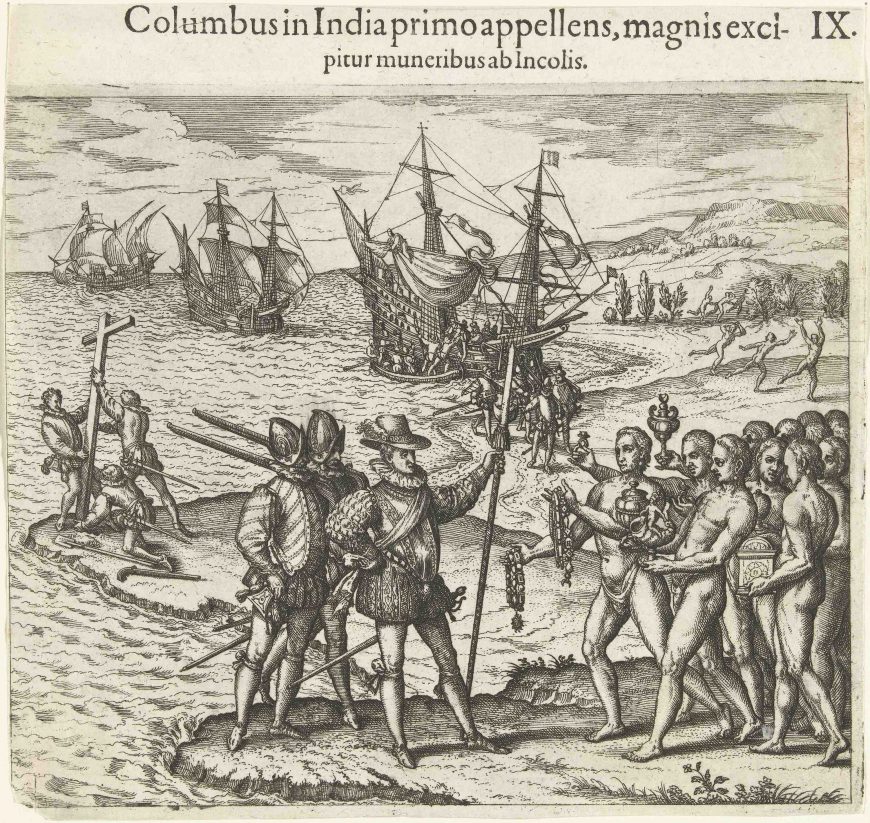
Theodore de Bry, Christopher Columbus arrives in America, 1594, engraving, 18.6 c 19.6 cm, from Collected travels in the east Indies and west Indies (Collectiones peregrinationum in Indiam occidentalem), vol. 4: Girolamo Benzoni, Americae pars quarta. Sive, Insignis & admiranda historia de primera occidentali India à Christophoro Columbo (Frankfurt am Main: T. de Bry, 1594) (Rijksmuseum)
Unclothed Taínos, the Indigenous peoples of the island of Ayiti (better known by the later Spanish name, Hispaniola), walk toward Columbus bringing gifts of necklaces and other precious objects. Further in the background, on the right side of the print, other Taínos, with arms raised and twisting bodies, flee in fear from the Spanish ships anchored offshore.
This print from 1592, by the engraver Theodore de Bry, presents Columbus and his men as the harbingers of European civilization and faith, and juxtaposes them with Taínos, who are presented as uncivilized, unclothed, and pagan. This print, along with hundreds of others de Bry made for his 27 volume series, published over more than forty years, Collected travels in the east Indies and west Indies (1590–1634), affirm and assert a sense of European superiority, as well as invent for Europeans what America—both its land and its people—was like.
Though de Bry is most famous for his engravings of European voyages to the Americas (and Africa and Asia), he never actually traveled across the Atlantic. It is not surprising then that de Bry’s depiction of the Indigenous peoples of the Americas was a combination of the work of other artists who had accompanied Europeans to the Americas (artists were often brought on journeys in order to document the lands and peoples of the Americas for a European audience) as well as his own artistic inventions. For instance, he adapted (without credit) some of the images created by Johannes Stradanus, a well-known illustrator who created early images of the Americas. In his Collected travels in the east Indies and west Indies, de Bry republished (and translated into multiple languages) the accounts of others who had spent time traveling around the globe, and created more than 600 engravings to illustrate the volumes. The engraving above of Columbus and the Taínos comes from volume 4 of the Collected travels in the east Indies and west Indies. This volume reprinted the accounts of the Milanese traveler Girolamo Benzoni, who himself had drawn on the accounts of Columbus in his own writings.
The volumes of the Collected travels in the east Indies and west Indies that treat the voyages across the Atlantic to the Americas are known as the Grands Voyages, while the Petit Voyages (small voyages), were those to Africa and Asia.
Documenting America
De Bry’s copperplate engravings were among the first images that Europeans encountered about the peoples, places, and things of the Americas, even if he began making them almost a century after Columbus’s initial voyage. In the engraving with Columbus on the shoreline, the barely clothed Taínos resemble Greco-Roman sculptures, especially their poses and musculature. De Bry apparently had no interest in documenting the actual appearance of the Taínos.
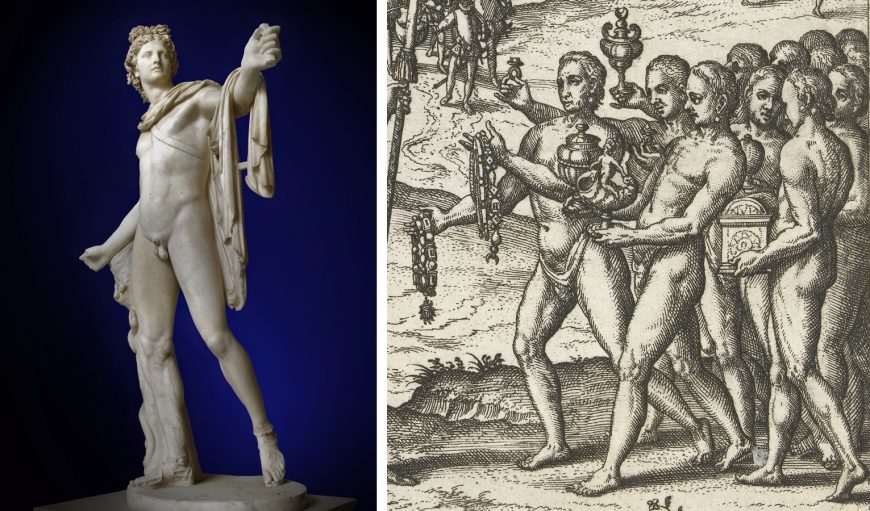
Left: Apollo Belvedere, c. 150 C.E., Roman copy of an original bronze statue of 330–320 B.C.E. (Vatican Museums) (photo: Tetraktys, CC BY-SA 3.0); right: detail. Theodore de Bry, Christopher Columbus arrives in America, 1594, etching and text in letterpress, 18.6 c 19.6 cm (Rijksmuseum)
De Bry’s Collected travels belongs to the genre of travel literature, which had been popular since the Middle Ages. Accounts of the Americas became wildly popular after Columbus’s first voyage. For example, Columbus’s 1493 letter to King Ferdinand and Queen Isabel (who had helped finance the voyage) was published in seventeen editions by 1497, and often included woodcuts depicting select moments of his voyage.
De Bry and his audiences
De Bry was a Protestant, and fled Liège (today in Belgium) where he was born to avoid persecution. He made his way to Frankfurt, which is where he started work on Grands Voyages. After his death in 1598, his family continued his work and finished the remaining volumes in 1634. Interestingly, different versions of the Grands Voyages catered to different Christian confessional groups. The volumes in German were geared towards Protestants, while those in Latin appealed to Catholics. De Bry created images that he could market to either audience, but he made changes to the texts to appeal more to either Catholics or Protestants. Psalms that Calvinists felt encapsulated their beliefs or longer passages criticizing Catholic beliefs or colonial practices were omitted from Latin versions, which were often filled in with more engravings duplicated from other parts of the text.
General subjects of the Grands Voyages engravings
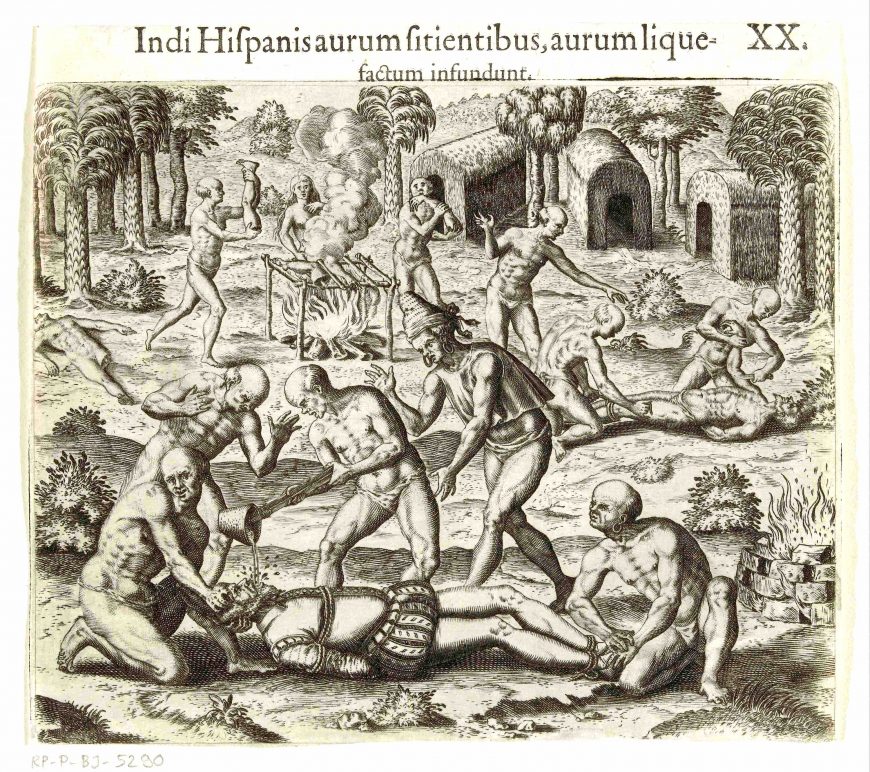
Theodore de Bry, Indians pour liquid gold into the mouth of a Spaniard, 1594, from Collected travels in the east Indies and west Indies (Collectiones peregrinationum in Indiam occidentalem)
While some of de Bry’s prints in Grands Voyages focus on the exploits of famed European navigators like Columbus, others show Indigenous groups and their customs. Some of these images display the atrocities that occurred in the wake of Europeans’ arrival, violent conquest, and colonization. Indigenous peoples are fed to dogs, hanged, or butchered. Still others depict native responses to the European invasion, such as drowning Spaniards in the ocean or pouring liquid gold into invaders’ mouths.
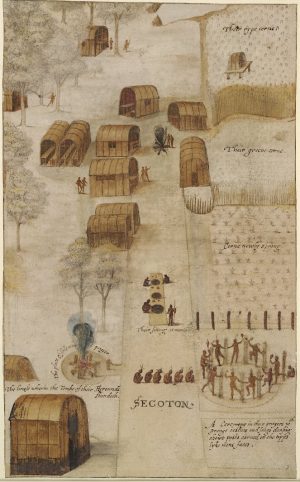
John White, The town of Secoton (bird’s-eye view of town with houses, lake at the top, fire, fields and ceremony), 1585-1593, watercolour over graphite, heightened with white (British Museum)
Travels to Virginia
The Grands Voyages (the section on cross-Atlantic voyages) begins with a reprint of an earlier text by the English colonist Thomas Hariot, A Brief and True Report of the New Found Land of Virginia (1590). It also includes translations of this text into Latin, German, and French. De Bry’s accompanying engravings were based on watercolors by John White, who had settled on Roanoke Island, North Carolina in 1585 and who had created paintings while there. His watercolors document clothing, dwellings, and rituals of the eastern Algonquian peoples.
Even though Virginia and North Carolina were colonized by Europeans after they had seized other areas in the Americas, de Bry placed them in the first volume of his Grands Voyages. This may be because he had visited London just after Hariot’s book was published in 1588, and was given both that text and the watercolors of White. De Bry was clearly not interested in a providing a chronological account of European exploration and colonization.
One of White’s paintings represents the town of Secoton, with people going about their daily life activities. In the right foreground people dance in a circle. Corn grows in neat rows. Dwellings line a road. In his engraving, de Bry made several changes to White’s watercolor. He expanded the village and removed the textual inscriptions that identified important features of the village (instead incorporating a separate key).
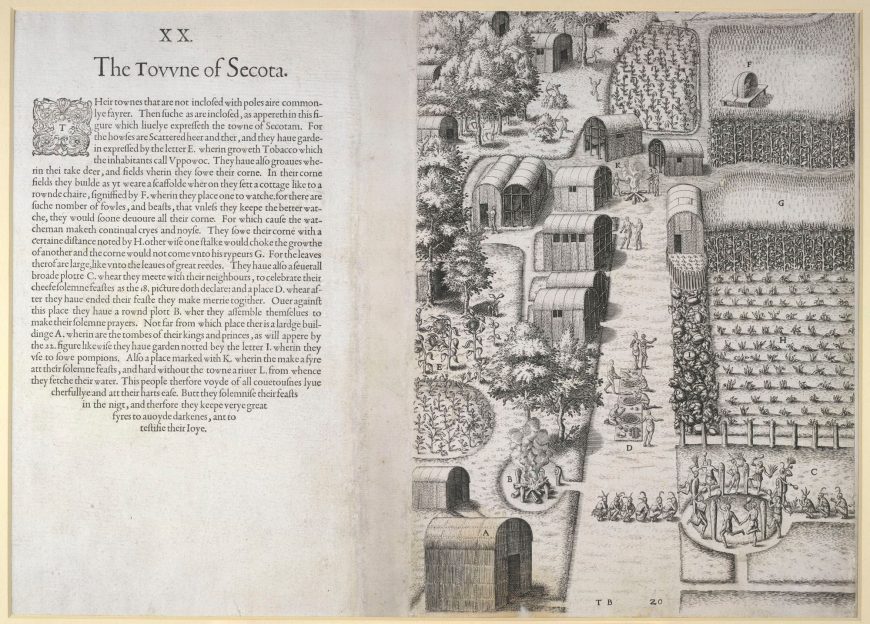
Theodore de Bry, Bird’s-eye view of a native American village (Secoton), 1590, engraving (after the watercolor by John White above) for volume 1 of Collected travels in the east Indies and west Indies which reprinted Thomas Hariot, A briefe and true report of the new found land of Virginia, of the commodities and of the nature and manners of the naturall inhabitants (British Library)
For his engravings, de Bry also transformed watercolors White had created of Scottish Picts (an ancient pagan Indigenous peoples of Scotland who lived in a loose confederation of groups and who painted their bodies). But why include a discussion of Picts in a book on the Americas?
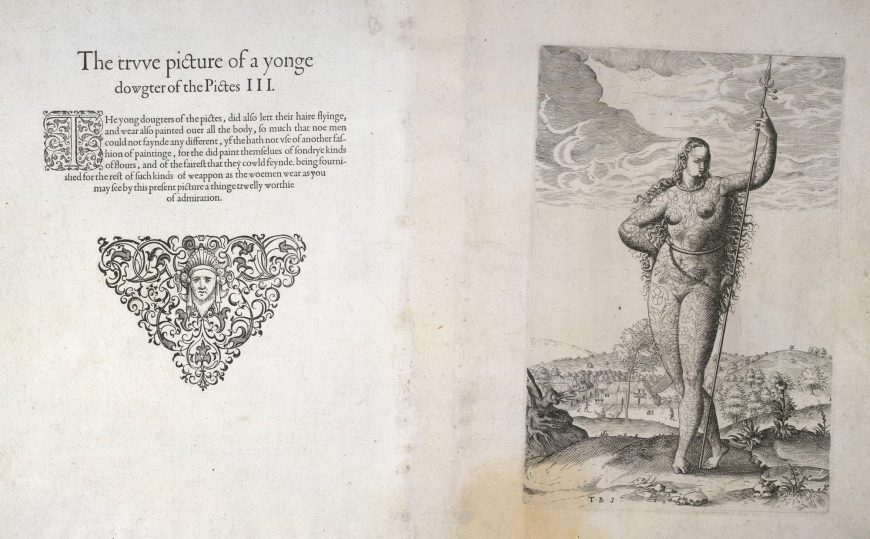
Theodore de Bry, A Young Daughter of the Picts, 1590, engraving (after a watercolor by Jacques Le Moyne de Morgues — originally attributed to John White) for Collected travels in the east Indies and west Indies which reprints Thomas Hariot, A briefe and true report of the new found land of Virginia, of the commodities and of the nature and manners of the naturall inhabitants (British Library)
Hariot’s text states that “Some picture of the Picts which in the old time did inhabit one part of the great Britain,” which according to him “show how that the inhabitants of the great Britain have been in times past as savage as those of Virginia.” [1] White compares them to the Algonquian peoples to suggest that Europe has its own history of uncivilized, pagan people. Despite attempting to reconcile the Algonquian peoples with the Picts in Europe, the manner in which he compares them—as savages—speaks to a presumed European superiority.

Theodore de Bry, Indians worship the column in honor of the French king, 1591, engraving for Collectiones peregrinationum in Indiam occidentalem, vol. 2: René de Laudonnière, Brevis narratio eorum quae in Florida Americae provincia Gallis acciderunt (Frankfurt am Main: J. Wechelus, 1591) (Rijksmuseum)
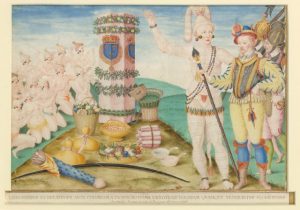
Jacques Le Moyne de Morgues, Laudonnierus et rex athore ante columnam a praefecto prima navigatione locatam quamque venerantur floridenses, gouache (New York Public Library)
Travels to Florida
Volume 2, published in 1591, focused on French voyages to Florida, and was based on the accounts of the French colonist René Goulaine de Laudonnière. De Bry created engravings based on the watercolors of Jacques Le Moyne de Morgues, who was part of the French expeditions to Florida that were headed by Jean Ribault in 1562 and Laudonnière in 1564. One of the engravings adapted from Le Moyne’s watercolors shows the Timucua worshipping a column that had supposedly been erected by Ribault. The most prominent figure, identified as chief Athore, stands next to Laudonnière, who has followed him to see the sight. The other Timucua kneel, while raising their arms in gestures of reverence in the direction of the column, itself decorated with garlands. Before it, offerings of food and vegetables abound. De Bry made several notable changes to the print, such as adjusting Athore’s features to look more European, with raised cheekbones and an aquiline nose. Le Moyne’s earlier watercolor had also Europeanized the Timucua peoples: he paints them with the same complexion as Laudonnière, but with even blonder hair.
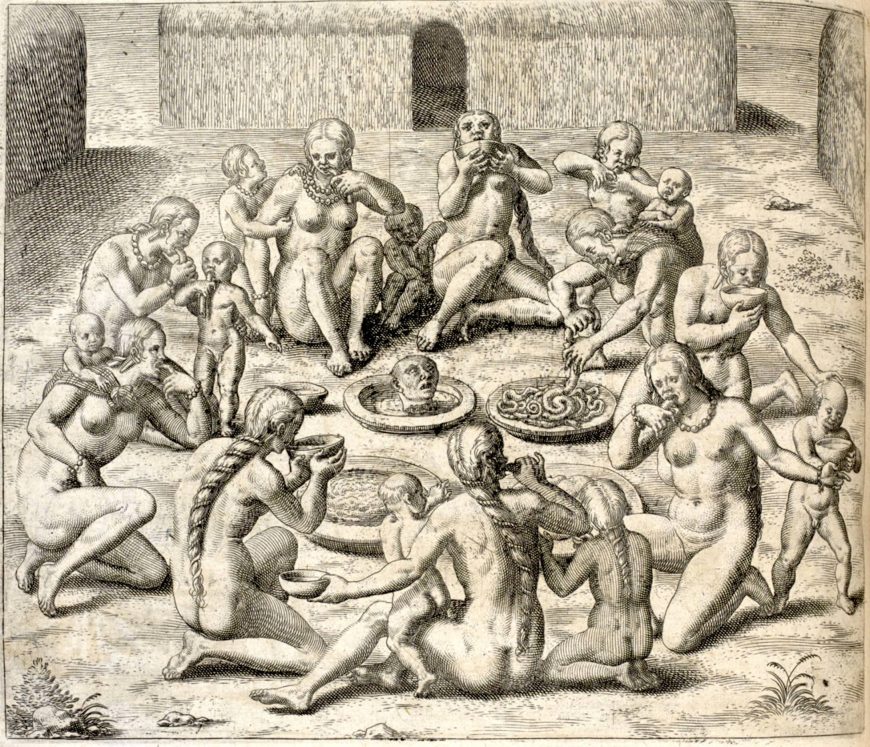
Theodore de Bry, engraving depicting cannibalism in Brazil for volume 3 of Collected travels in the east Indies and west Indies which reprinted Hans Staden’s account of his experiences in Brazil, 1594 (British Library)
Cannibalism in Brazil
Cannibalism was (and remains) commonly associated with certain Indigenous peoples of the Americas. In de Bry’s series, his third volume recounted Hans Staden’s experiences of cannibalism in Brazil. De Bry’s engravings for this volume were among the most well-known in the late sixteenth and early seventeenth century, in large part because of their gruesome and sensationalistic character. Note that de Bry’s print, “Indians pour liquid gold into the mouth of a Spaniard,” may also depict cannibalism among the figures shown in the background.
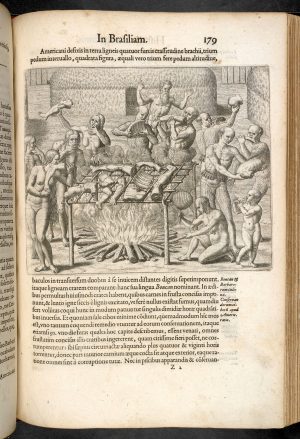
Theodore de Bry, engraving depicting cannibalism in Brazil for volume 3 of Collected travels in the east Indies and west Indies which reprinted Hans Staden’s account of his experiences in Brazil, 1594 (British Library)
Staden, a German soldier who traveled to South America, had been captured in 1553 by the Tupinambá, an Indigenous group in Brazil. After his return to Europe in 1557, he wrote about Tupinambá customs, family life, and cannibalism, describing how the Tupinambá practiced it ceremonially, especially eating their enemies. Staden’s initial book included simple woodcuts, but de Bry’s updated engravings proved far more popular and enduring in the European cultural imagination. Perceptions of Indigenous Brazilians were shaped by these images, and reinforced the notion that the Tupinambá, and others like them, were depraved, primitive, and sinful.
One of his images depicts naked adults and children drinking a broth made from a human head and intestines, visible on plates amidst the gathering of people. Another depiction of the Tupinamba shows a fire below a grill, upon which body parts are roasted. Figures surround the grill, eating. In the back is a bearded figure, most likely intended to be Staden. Hand-colored versions of de Bry’s prints emphasize the disturbing subject of the images even more.
Cannibalism would come to be closely associated with peoples of the Americas. De Bry would even use images of cannibals to serve as the engraved frontispiece to volume 3. Showing the Tupinambá eating human flesh exoticized them, and justified European control.
Other volumes and the legacy of de Bry
The fourth, fifth, and sixth volumes of the set focus on Girolamo Benzoni’s accounts, such as Historia Mondo Nuovo, with part 6 discussing the atrocities committed against the Indigenous population of Peru. Parts 7 to 12 incorporated the travel accounts of Ulricus Faber, Sir Francis Drake and Walter Raleigh, José de Acosta, Amerigo Vespucci, John Smith, and Antonio de Herrera among others. Like the volumes that came before them, de Bry provided numerous images to increase readers understanding of the narratives.
The Grands Voyages, and the entire Collected Travels, relate more generally to the forms of knowledge and collecting popular at the time. Like a cabinet of curiosity, de Bry’s project organized information in text and images so that readers could come to know the Americas. The volumes seek to provide encyclopedic knowledge about the Americas, much as the objects did in a curiosity cabinet. De Bry’s many prints were important resources for Europeans who sought to better understand the Americas. It allowed readers to take possession of these distant lands and peoples, where they could become participants in the colonial projects then underway, allowing them to feel a sense of dominance over the peoples and lands across the Atlantic—lands which many in Europe would never see firsthand. These often inaccurate images and narratives supported a sense of superiority, with Europeans positioned as more civilized and advanced, and the American “others” as less so. De Bry’s images of America would cement for Europeans a vision of what America was like for centuries to come.


